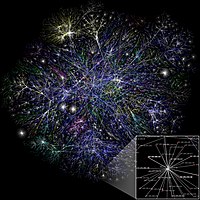
Photo from wikipedia
Abstract Urban scenes consist of visual and semantic features and exhibit spatial relationships among land-use types (e.g. industrial areas are far away from the residential zones). This study applied a… Click to show full abstract
Abstract Urban scenes consist of visual and semantic features and exhibit spatial relationships among land-use types (e.g. industrial areas are far away from the residential zones). This study applied a graph convolutional network with neighborhood information (henceforth, named the neighbour supporting graph convolutional neural network), to learn spatial relationships for urban scene classification. Furthermore, a co-occurrence analysis with visual and semantic features proceeded to improve the accuracy of urban scene classification. We tested the proposed method with the fifth ring road of Beijing with an overall classification accuracy of 0.827 and a Kappa coefficient of 0.769. In comparison with other methods, such as support vector machine, random forest, and general graph convolutional network, the case study showed that the proposed method improved about 10% in urban scene classification.
Journal Title: International Journal of Geographical Information Science
Year Published: 2022
Link to full text (if available)
Share on Social Media: Sign Up to like & get
recommendations!